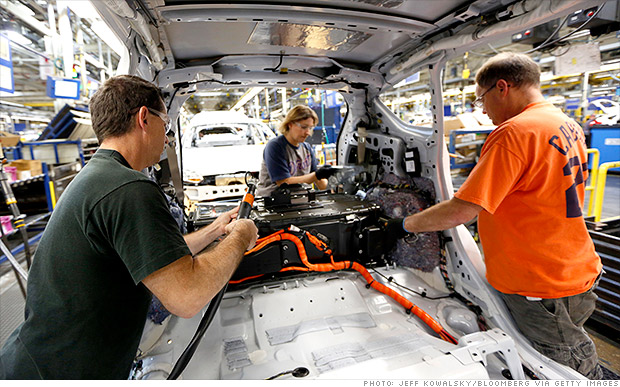
It’s a big cut by a large utility with significant implications for the rest of the industry. Indeed the world is changing for US electric utilities, a point we’ve emphasized here and in in the pages of Utility Forecaster since May 2013, as several forces combine to rend a regime in place for more than a century.
And nothing illustrates this scenario better than the decision by FirstEnergy Corp (NYSE: FE) to cut its dividend by 34.5 percent from $0.55 per share per quarter, or $2.20 on an annualized basis, to $0.36 per share per quarter, or $1.44 per year.
Among these are substantial influences such as a slow recovery from the Great Recession, the influence of low natural gas prices on wholesale power markets, low interest rates and the rise of distributed power and ostensibly lesser drags such as more efficient light bulbs.
By the time I assumed the role as Editor and Chief Investment Strategist of UF Exelon Corp (NYSE: EXC) had already announced its 40.9 percent dividend cut, Atlantic Power Corp (TSX: ATP, NYSE: AT) its 65.2 percent reduction.
Both Exelon and Atlantic were undermined by the steep slowdown for the wholesale market, where a long slide for natural gas prices catalyzed by exploitation of shale deposits via new technologies have dragged down prices for power producers.
FirstEnergy is the first major utility to cut its dividend since May 2013, but it won’t be the last.
The board, at the end of a “thorough” study of the company’s businesses, concluded that a dividend rate “aligned” with revenue and earnings generated by regulated operations “will provide the best path forward for FirstEnergy.”
Based on reported earnings per share for the trailing 12 months of $2.33, FirstEnergy’s payout ratio under the old, $2.20 per share annualized dividend rate was 94.5 percent. The reduced rate of $1.44 translates to a much more manageable 61.9 percent.
Including the consensus estimate for 2013 fourth-quarter EPS with actual reported results for the first three quarter of the year the 2013 payout ratio, based on total dividends of $2.20 and management’s updated EPS guidance of $2.95 to $3.05, will come in between 72.1 percent and 74.6 percent.
FirstEnergy’s payout ratio for 2009 was 58.4 percent. It rose to 60.8 percent in 2010, 64.7 percent in 2011 and 65.7 percent in 2012.
The 2013 payout ratio at the $1.44 annualized rate would have been between 47.2 percent and 48.8 percent. The average payout ratio for FirstEnergy’s Diversified Energy peers in the Utility Forecaster How They Rate coverage universe through the third quarter of 2013 was 60.3 percent.
TECO Energy Inc (NYSE: TE), a member of the UF Dividend Watch List, was highest at 94.6 percent. AES Corp (NYSE: AES), the January 2014 UF Growth Spotlight, was lowest at 12.4 percent.
FirstEnergy is dealing with particular problems, chief among them an economic recovery that’s unfolded much more slowly than management anticipated.
When considering the longer-term sustainability of its dividend FirstEnergy weighed the mix of business among regulated and competitive operations. Reducing the payout will allow greater flexibility as management maximizes investment in regulated operations.
Coloring this discussion were economic conditions, competitive market realities and “increasingly more costly regulatory and environmental mandates.”
The multiyear economic downturn has directly affected FirstEnergy in many ways, including essentially no load growth at its utilities and declining energy prices.
At the same time capacity auctions run by PJM Interconnection for regional power transmission have resulted in “unpredictable and inadequate results” for FirstEnergy’s competitive operations.
And significant storms in 2011 and 2012 put additional pressure on cash flow, as more than $1 billion in storm-related expenditures are yet to be recovered.
FirstEnergy’s 10 electric utility operating companies make up one of the largest investor-owned electric systems. It serves a total of 6 million customers within a 67,000-square-mile area of Ohio, Pennsylvania, West Virginia, Virginia, Maryland, New Jersey and New York.
Its generation subsidiaries control more than 23,000 megawatts of capacity, and its distribution lines span over 194,000 miles.
The biggest upside driver for FirstEnergy’s competitive business, which includes more than 13,000 megawatts of generating assets that serve more than 2.7 million retail customers, will be better wholesale power prices. And improvement here will be driven by rising natural gas prices.
Management will boost spending on maintenance capital to make the existing fleet more efficient but not larger. And it will spend that money only if the effort is “justified by fundamental upward shifts in market dynamics.”
The main focus is now on regulated growth opportunities, with extra free cash from competitive operations earmarked to support this strategy or to strengthen the balance sheet. Management expects FirstEnergy’s regulated utility and transmission businesses to fully support the $1.44 annual dividend going forward.
The Bigger Picture
According to data compiled by the Edison Electric Institute (EEI), shareholder-owned electric utilities filed four rate cases during the third quarter of 2013, the fewest in a quarter since 2005. The single-period data point, however, doesn’t likely mark a new trend or even a moderation of the recent strong pace of new filings, which reflects a construction cycle driven by the need to replace infrastructure and reduce the environmental impact of power generation.
For many years, elevated capital spending, followed by rising operation and maintenance expenses, have been the main drivers of rate case filings.
Recently, however, utilities have been trying to recover spending by means other than the traditional, all-inclusive rate case, a proceeding that can take a year or more to be decided.
More and more, state lawmakers and regulators are approving the use of targeted charges to compensate a utility for a singular type of expenditure, whether they’re called riders, surcharges, trackers or adjustment clauses.
The third quarter followed this pattern, with attempts to implement rate mechanisms acting as a relatively important cause of new filings, followed by recovery of operation and maintenance expenses. Concerns about utility returns and storm and other reliability-related expenses were also factors.
At the most basic level, however, utilities’ costs and their return on investment are directly linked to the kilowatt-hours billed to consumers. This traditional utility business model works when electricity consumption is rising consistently–and at rates that prevailed for most of the 20th century.
But that’s no longer happening. During the 10 years through 2012 electricity demand grew by an average of 0.6 percent per year. During the 10 years through it grew by an average of 2.3 percent per year. The US Energy Information Administration forecast on Dec. 16, 2013, that usage will be flat through 2015 and then grow by about 1 percent per year.
US power sales have declined in four of the past five years in part because of energy conservation and increasing use of private rooftop solar panels, according to the US Energy Information Administration (EIA). Electricity use is expected to be unchanged through 2015 and then grow at about 1 percent annually, according to a Dec. 16, 2013, report from the EIA.
Improvements in appliance and lighting energy efficiency have helped slow the growth in residential electricity use in recent years. Average household consumption is expected to decline 1.1 percent in 2014 and 0.4 percent in 2015.
Some of this slowdown is cyclical, a result of the biggest economic downturn since the Great Depression and a still-fitful recovery for household finances and business spending. And a return to more normal growth for the US economy will drive industrial demand.
But the trend is clear: Kilowatt-hours per dollar of gross domestic product has declined by 1 percent per year for 30 years. And electricity use per capita peaked in 2007 and has since declined by 6.4 percent.
As silly as it seems, the move to more efficient light bulbs from technology that’s been around since the late 1800s could put more drag on demand.
As of Jan. 1, 2014, as mandated by the US Congress, venerable tungsten-filament 40- and 60-watt incandescent light bulbs can no longer be manufactured in the US because they don’t meet federal energy-efficiency standards.
It’s the last part of a gradual phase-out that began in 2012 with 100-watt bulbs and continued in 2013 with the 75-watt variety. This final stage–the 40s and 60s–accounts for more than 50 percent of the market. And it could bring to zero the power demand growth otherwise forecast through 2015.
Utilities, coming off a period of significant capital expenditure, are now in the difficult spot of having to press for higher rates on each kilowatt-hour to make a decent return on investment.
In the 10 years through 2012 the utility industry’s net asset base grew at a compound annual rate of 6.4 percent, or approximately 10 times the rate of demand growth. That kind of math requires continuing growth for consumers’ bills.
But the average awarded return on equity (ROE) for the four rate cases decided during the third quarter of 2013 was 10.05 percent. The second-quarter average, drawn from 16 decisions, was 9.77 percent, the lowest figure in an EEI data set that goes back to the first quarter of 1990.
But this is a decades-long trend of declining awarded ROEs, corresponding with a period of declining interest rates. The 10-year US Treasury yield has spiked in recent months on changing Federal Reserve monetary policy, but state regulators will also continue to consider financial hardships for many customers in 2014 cases.
And though rates seem to have finally embarked on an upward trajectory off historically low levels, the rise may not necessarily translate to higher allowed ROEs.
Fuel costs, another part of the rate-making equation, are still at historic lows and look set to rise. At the same time, electricity charges are up 36 percent since 2003, rising at twice the rate of median household income. That makes it a hard sell to pass on increases to customers.
And here’s where the shape and texture of the bigger picture really begins to change: As rates run higher, customers will have greater financial incentive to install solar panels and get off the grid.
The distributed power migration–leaving a narrower customer base–is already leading electric utilities to cut costs. One obvious solution to this problem of shrinking revenue and margins is to increase scale via mergers and acquisitions.
FirstEnergy had already been floated as a potential takeover target before it announced its dividend cut. Other potential candidates include smaller utilities with more concentrated service territories in areas with stronger economic growth or better longer-term prospects.
The acquisition by Warren Buffett’s MidAmerican Energy Holdings Co of NV Energy Inc (NYSE: NVE) was a function of the latter, as the Nevada economy, battered worse than most by the Great Recession, looks like a compelling long-term value play.
And with its December 2013 offer to buy Arizona-based UNS Energy Corp (NYSE: UNS) for $2.5 billion in cash St. John’s, Newfoundland and Labrador-based Fortis Inc (TSX: FTS, OTC: FRTSF), making its second foray in the US in two years, signaled its interest in regulated utility assets in states with favorable population and economic trends as a means of driving its growth going forward.




 Ford F-150: Lighter and more efficient
Ford F-150: Lighter and more efficient 
